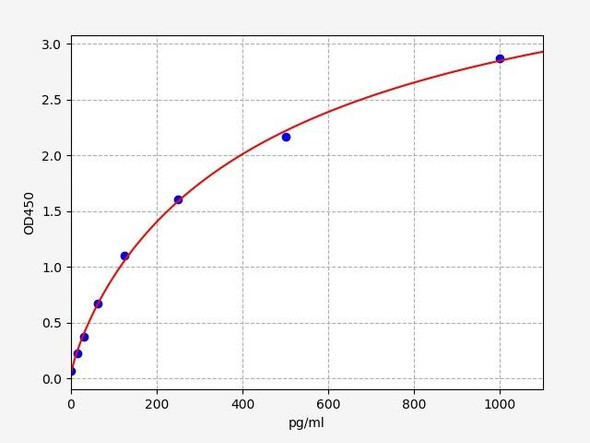Rat Alpha-synuclein ELISA Kit
- SKU:
- RTFI00748
- Product Type:
- ELISA Kit
- Size:
- 96 Assays
- Uniprot:
- P37377
- Sensitivity:
- 9.375pg/ml
- Range:
- 15.625-1000pg/ml
- ELISA Type:
- Sandwich ELISA, Double Antibody
- Synonyms:
- SNCa, NACP, PARK1, PARK4, PD1, SNCA, Lewy body 4, MGC110988, non A-beta component of AD amyloid, Non-A beta component of AD amyloid, non-A4 component of amyloid, Non-A4 component of amyloid precursor, PARK1, PARK4, synuclein, alpha, non A4 component
- Reactivity:
- Rat
Description
| Product Name: | Rat SNCa (Synuclein Alpha) ELISA Kit |
| Product Code: | RTFI00748 |
| Size: | 96 Assays |
| Target: | Rat SNCa |
| Alias: | SNCa, NACP, PARK1, PARK4, PD1, SNCA, Lewy body 4, MGC110988, non A-beta component of AD amyloid, Non-A beta component of AD amyloid, non-A4 component of amyloid, Non-A4 component of amyloid precursor, PARK1, PARK4, synuclein, alpha, non A4 component of amyloid precursor |
| Reactivity: | Rat |
| Detection Method: | Sandwich ELISA, Double Antibody |
| Sensitivity: | 9.375pg/ml |
| Range: | 15.625-1000pg/ml |
| Storage: | 4°C for 6 months |
| Note: | For Research Use Only |
| Recovery: | Matrices listed below were spiked with certain level of Rat SNCa and the recovery rates were calculated by comparing the measured value to the expected amount of Rat SNCa in samples. | ||||||||||||||||
| |||||||||||||||||
| Linearity: | The linearity of the kit was assayed by testing samples spiked with appropriate concentration of Rat SNCa and their serial dilutions. The results were demonstrated by the percentage of calculated concentration to the expected. | ||||||||||||||||
| |||||||||||||||||
| Intra-Assay: | CV <8% | ||||||||||||||||
| Inter-Assay: | CV <10% |
| Uniprot: | P37377 |
| UniProt Protein Function: | SNCA: a member of the synuclein family. Abundantly expressed in the brain. Inhibits phospholipase D2 selectively. May integrate presynaptic signaling and membrane trafficking. Implicated in the pathogenesis of Parkinson's disease. A major component of amyloid plaques in the brains of patients with Alzheimer's disease. Two alternatively spliced isoforms transcripts have been identified. |
| UniProt Protein Details: | Protein type:Adaptor/scaffold Cellular Component: actin cytoskeleton; axon; cell cortex; cell junction; cytoplasm; cytoplasmic vesicle membrane; cytoskeleton; cytosol; extracellular space; fibril; Golgi apparatus; growth cone; inclusion body; intracellular membrane-bound organelle; membrane; mitochondrion; nerve terminal; nuclear outer membrane; nucleus; perinuclear region of cytoplasm; plasma membrane; platelet alpha granule membrane; ribosome; rough endoplasmic reticulum; synapse; synaptic vesicle; terminal button Molecular Function:alpha-tubulin binding; arachidonic acid binding; beta-tubulin binding; calcium ion binding; caspase inhibitor activity; copper ion binding; dynein binding; enzyme binding; fatty acid binding; ferrous iron binding; histone binding; identical protein binding; kinesin binding; magnesium ion binding; microtubule binding; oxidoreductase activity; phospholipase binding; phospholipid binding; phosphoprotein binding; protein binding; protein domain specific binding; protein N-terminus binding; tau protein binding; zinc ion binding Biological Process: adult locomotory behavior; aging; behavioral response to cocaine; calcium ion homeostasis; caspase activation; dopamine biosynthetic process; dopamine metabolic process; fatty acid metabolic process; microglial cell activation; mitochondrial membrane organization and biogenesis; negative regulation of apoptosis; negative regulation of caspase activity; negative regulation of dopamine metabolic process; negative regulation of dopamine uptake; negative regulation of exocytosis; negative regulation of histone acetylation; negative regulation of microtubule polymerization; negative regulation of monooxygenase activity; negative regulation of neuron apoptosis; negative regulation of norepinephrine uptake; negative regulation of protein amino acid phosphorylation; negative regulation of serotonin uptake; negative regulation of transporter activity; neutral lipid metabolic process; organelle ATP synthesis coupled electron transport; phospholipid metabolic process; positive regulation of endocytosis; positive regulation of neurotransmitter secretion; positive regulation of peptidyl-serine phosphorylation; positive regulation of receptor recycling; positive regulation of release of sequestered calcium ion into cytosol; positive regulation of synaptic transmission; protein destabilization; receptor internalization; regulation of acyl-CoA biosynthetic process; regulation of dopamine secretion; regulation of excitatory postsynaptic membrane potential; regulation of glutamate secretion; regulation of locomotion; regulation of long-term neuronal synaptic plasticity; regulation of macrophage activation; regulation of neuron apoptosis; regulation of neuronal synaptic plasticity; regulation of neurotransmitter secretion; response to cocaine; response to drug; response to iron(II) ion; response to lipopolysaccharide; response to magnesium ion; synapse organization and biogenesis; synaptic transmission; synaptic transmission, dopaminergic; synaptic vesicle endocytosis; synaptic vesicle transport |
| NCBI Summary: | may play a role in regulation of synaptic vesicle biogenesis and organization; may be involved in neurotransmission [RGD, Feb 2006] |
| UniProt Code: | P37377 |
| NCBI GenInfo Identifier: | 9507125 |
| NCBI Gene ID: | 29219 |
| NCBI Accession: | NP_062042.1 |
| UniProt Secondary Accession: | P37377,P37378, Q53YM9, |
| UniProt Related Accession: | P37377 |
| Molecular Weight: | 41.9kD |
| NCBI Full Name: | alpha-synuclein |
| NCBI Synonym Full Names: | synuclein alpha |
| NCBI Official Symbol: | Snca |
| NCBI Protein Information: | alpha-synuclein |
| UniProt Protein Name: | Alpha-synuclein |
| Protein Family: | Alpha-synuclein |
| UniProt Gene Name: | Snca |
| UniProt Entry Name: | SYUA_RAT |
| Step | Procedure |
| 1. | Set standard, test sample and control (zero) wells on the pre-coated plate respectively, and then, record their positions. It is recommended to measure each standard and sample in duplicate. Wash plate 2 times before adding standard, sample and control (zero) wells! |
| 2. | Aliquot 0.1ml standard solutions into the standard wells. |
| 3. | Add 0.1 ml of Sample / Standard dilution buffer into the control (zero) well. |
| 4. | Add 0.1 ml of properly diluted sample ( Human serum, plasma, tissue homogenates and other biological fluids.) into test sample wells. |
| 5. | Seal the plate with a cover and incubate at 37°C for 90 min. |
| 6. | Remove the cover and discard the plate content, clap the plate on the absorbent filter papers or other absorbent material. Do NOT let the wells completely dry at any time. Wash plate X2. |
| 7. | Add 0.1 ml of Biotin- detection antibody working solution into the above wells (standard, test sample & zero wells). Add the solution at the bottom of each well without touching the side wall. |
| 8. | Seal the plate with a cover and incubate at 37°C for 60 min. |
| 9. | Remove the cover, and wash plate 3 times with Wash buffer. Let wash buffer rest in wells for 1 min between each wash. |
| 10. | Add 0.1 ml of SABC working solution into each well, cover the plate and incubate at 37°C for 30 min. |
| 11. | Remove the cover and wash plate 5 times with Wash buffer, and each time let the wash buffer stay in the wells for 1-2 min. |
| 12. | Add 90 µL of TMB substrate into each well, cover the plate and incubate at 37°C in dark within 10-20 min. (Note: This incubation time is for reference use only, the optimal time should be determined by end user.) And the shades of blue can be seen in the first 3-4 wells (with most concentrated standard solutions), the other wells show no obvious color. |
| 13. | Add 50 µL of Stop solution into each well and mix thoroughly. The color changes into yellow immediately. |
| 14. | Read the O.D. absorbance at 450 nm in a microplate reader immediately after adding the stop solution. |
When carrying out an ELISA assay it is important to prepare your samples in order to achieve the best possible results. Below we have a list of procedures for the preparation of samples for different sample types.
| Sample Type | Protocol |
| Serum: | If using serum separator tubes, allow samples to clot for 30 minutes at room temperature. Centrifuge for 10 minutes at 1,000x g. Collect the serum fraction and assay promptly or aliquot and store the samples at -80°C. Avoid multiple freeze-thaw cycles. If serum separator tubes are not being used, allow samples to clotovernight at 2-8°C. Centrifuge for 10 minutes at 1,000x g. Removeserum and assay promptly or aliquot and store the samples at-80°C. Avoid multiple freeze-thaw cycles. |
| Plasma: | Collect plasma using EDTA or heparin as an anti-coagulant. Centrifuge samples at 4°C for 15 mins at 1000 — g within 30 mins of collection. Collect the plasma fraction and assay promptly or aliquot and store the samples at -80°C. Avoid multiple freeze-thaw cycles.Note: Over haemolysed samples are not suitable for use with this kit. |
| Urine & Cerebrospinal Fluid: | Collect the urine (mid-stream) in a sterile container, centrifuge for 20 mins at 2000-3000 rpm. Remove supernatant and assay immediately. If any precipitation is detected, repeat the centrifugation step. A similar protocol can be used for cerebrospinal fluid. |
| Cell Culture Supernatant: | Collect the cell culture media by pipette, followed by centrifugation at 4°C for 20 mins at 1500 rpm. Collect the clear supernatant and assay immediately. |
| Cell Lysates: | Solubilize cells in lysis buffer and allow to sit on ice for 30 minutes. Centrifuge tubes at 14,000 x g for 5 minutes to remove insoluble material. Aliquot the supernatant into a new tube and discard the remaining whole cell extract. Quantify total protein concentration using a total protein assay. Assay immediately or aliquot and store at ≤ -20°C. |
| Tissue Homogenates: | The preparation of tissue homogenates will vary depending upon tissue type. Rinse tissue with 1X PBS to remove excess blood & homogenizein 20ml of 1X PBS (including protease inhibitors) and store overnight at ≤ -20°C. Two freeze-thaw cycles are required to break the cell membranes. To further disrupt the cell membranes you can sonicate the samples. Centrifuge homogenates for 5 mins at 5000xg. Remove the supernatant and assay immediately or aliquot and store at -20°C or-80°C. |
| Tissue Lysates: | Rinse tissue with PBS, cut into 1-2 mm pieces, and homogenize with a tissue homogenizer in PBS. Add an equal volume of RIPA buffer containing protease inhibitors and lyse tissues at room temperature for 30 minutes with gentle agitation. Centrifuge to remove debris. Quantify total protein concentration using a total protein assay. Assay immediately or aliquot and store at ≤ -20 °C. |
| Breast Milk: | Collect milk samples and centrifuge at 10,000 x g for 60 min at 4°C. Aliquot the supernatant and assay. For long term use, store samples at -80°C. Minimize freeze/thaw cycles. |










